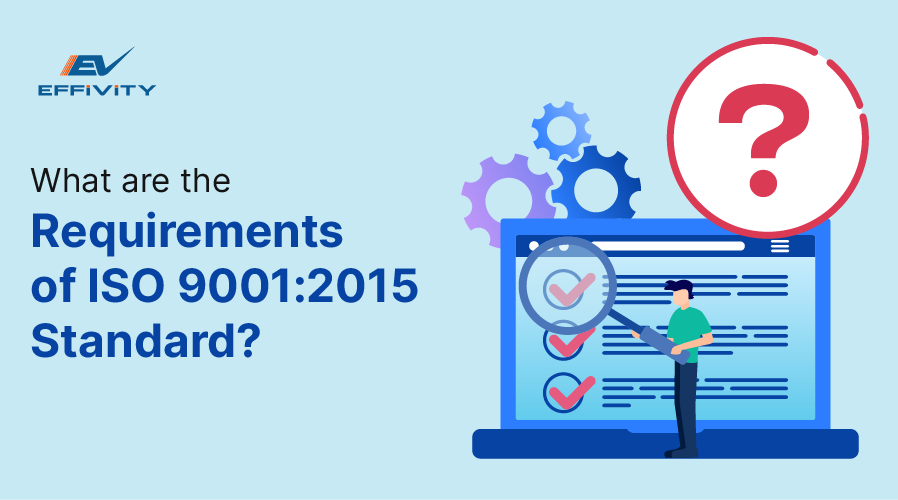For any business, thriving in a highly competitive market involves focusing on one critical area – the quality of business processes, products, and services. A way to achieve and maintain quality within the business is by implementing a quality management system under the ISO 9001:2015 standard.
The ISO 9001:2015 standard guides the implementation of a quality management system with specific requirements. These requirements apply to every organization seeking to demonstrate its commitment to quality management and ensure compliance with the standard.
In this article, we’ll walk you through the various requirements of the ISO 9001:2015 standard that you need to satisfy to maintain compliance.
ISO 9001:2015 Standard
ISO 9001:2015 is an internationally recognized standard for quality management system and the only standard in the ISO 9000 series to which organizations can certify. Since the standard applies to every organization, regardless of its size or nature, the standards are generic so that businesses can ensure compliance easily.
The ISO 9001:2015 standard allows organizations to achieve two broad objectives-
1. To demonstrate that it can consistently deliver products and services that-
- Meet customers’ requirements
- Meet the applicable regulatory or statutory requirements
2. To improve customer satisfaction
Within the ISO 9001 standard, there are 10 clauses or sections, along with additional subclauses for Plan-Do-Check-Act system. However, of all the sections, only clauses 4 to 10 contain ISO 9001 requirements that are auditable.
This means to achieve ISO 9001 certification; you need to fulfill the requirements in sections 4 to 10 of the ISO standard. These requirements can be classified into the following 7 categories-

1. Context of organization
2. Leadership
3. Planning
4. Support
5. Operation
6. Performance Evaluation
7. Improvement
While these requirements are straightforward to implement and manage, using automated QMS software will simplify the compliance process by offering dedicated modules for each requirement. With accessible dashboards and easy-to-use templates, organizations can plan processes, monitor QMS progress, manage documentation, and ensure everyone on the team is on top of the QMS requirements.
Requirements of ISO 9001:2015 Standard
Let’s explore these ISO 9001 requirements in detail.
1. Context of Organization (Clause 4)
The first step in implementing your quality management system is to align your business objectives with the QMS and identify internal or external issues that can impact the business. Your organization is not an isolated entity; it works within a particular context where it has to be mindful of the regulations and customer needs.
In line with this, the section requires you to define the internal and external causes that can impact your ability to meet the specific business objectives. External issues include political, environmental, social, economic, legislative, regulatory, and technological factors. Internal issues can arise as a result of these external factors. For instance, if labor laws change, you might have to change the employees’ working conditions to stay compliant.
Additionally, it involves identifying interested parties and their requirements and defining the scope of the QMS to help you satisfy the specific needs and improve business quality. Finally, this clause also involves defining and documenting the processes involved in the QMS, including interactions and criteria for effective operation.
2. Leadership (Clause 5)
A major change in the 2015 version of the ISO 9001 standard is the involvement of the top management, which should be able to demonstrate their involvement in the QMS.
The clause requires that the top management establishes and implements a quality policy that aligns with the company’s strategy and objectives and allocates roles and responsibilities to employees for implementing and maintaining the QMS. It also requires top management to demonstrate effective leadership by supporting other managers in the organization and assisting them in fulfilling their roles properly.
3. Planning (Clause 6)
The ISO 9001 standard now approaches planning from the perspective of change management. This section includes requirements for identifying and mitigating risks while capitalizing on opportunities, setting quality objectives aligned with the quality policy, and the actions to meet them.
Within ISO 9001:2015, all QMS-related processes must have their own objectives. And when these objectives are set within the QMS, they should highlight the specific risks and opportunities. In addition, any changes expected within the organization should also be planned, and any risks associated with them must be identified and mitigated.
4. Support (Clause 7)
Clause 7 of the standard requires the organizations to provide support for the implementation and maintenance of QMS. It consists of 5 key elements-
-
Awareness
The personnel must be aware of the need for the QMS, its policies and objectives, their contributions, and the implications of non-conformance.
-
Competence
The organization must define the level of competence required for a particular role to ensure that the employees have the necessary skills through education, training, and experience.
-
Resources
The organization must determine and provide all the resources needed for the effective implementation and maintenance of QMS. These resources include internal resources, people, organizational knowledge, external providers, and external communicators.
-
Communication
It is important to establish effective internal and external communication processes to ensure the QMS requirements are communicated to all interested parties.
-
Control of Documented Information
All the documented information must be controlled based on the specific requirements of access, integrity, and confidentiality mentioned in the standard.
5. Operation (Clause 8)
This clause defines the requirements for the processes needed to meet the desired quality of products and services. It requires that a process-based approach should be followed in all operational activities and processes, including planning, implementation, and measuring.
Here, the emphasis is on defining and setting procedures that will ensure that desired outcomes are achieved and the requirements of interested parties are met. This means creating process guides, documents, and records needed to create products or services and regular monitoring and inspection to ensure the highest level of quality is maintained.
6. Performance Evaluation (Clause 9)
Performance evaluation involves monitoring, measurement, analysis, and evaluation to ensure the effectiveness of the QMS. It includes monitoring aspects that the organization deems necessary, such as customer satisfaction, the effectiveness of planning, identification of risks and opportunities, and more.
Performance evaluation should also include internal audits to verify QMS conformity and effectiveness and regular management reviews.
7. Improvement
Continual improvement is a fundamental principle of ISO 9001:2015, which requires that organizations continually improve the QMS to enhance performance by using data insights to address nonconformities and take corrective actions to prevent recurrence.
In the End
While fulfilling the requirements of ISO 9001 might seem daunting at first, approaching it as a step-by-step plan can help you stay on top of the requirements and ensure compliance. By addressing each clause systematically, organizations can ensure they meet customer expectations, comply with relevant regulations, and achieve continual improvement in their operations.






























